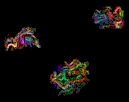Puzzle Piece Selections
The following terms are used on this site to refer to mathematical selections of puzzle pieces:
British Selection (“complete selection, disallowing reflections” or simply “complete selection”) a selection using all of the mathematical possibilities within certain parameters once each. Reflections of pieces are disallowed, in other words, the pieces may be “flipped over” without matching another piece. For example, here is the British Selection of tetrominoes:
![]()
This shows all of the ways of connecting 4 squares within a plane, disallowing reflections, rotations, etc.
Dutch Selection (“complete selection, allowing reflections”) a complete selection using all of the mathematical possibilities within certain parameters, including mirror images of any asymmetrical pieces. The pieces are single-sided; they CANNOT be “flipped over” or two pieces would end up being exactly the same. For example, here is the Dutch Selection of tetrominoes:
![]()
If flipping were allowed, the last two pieces would be exactly the same.
American Selection (“incomplete selection”) a partial selection using only a portion of all of the mathematical possibilities within certain parameters.
For example, using only 3 out of the 5 possible tetrominoes for a puzzle would be an American Selection.
In addition, any of these selections might be Mixed. A mixed selection is any that uses pieces from two or more mathematical sets. For example, Stewart Coffin’s Snowflake puzzle uses all of the trihexes and tetrahexes; it is therefore a British Mixed Selection. A puzzle that used only a portion of tetrominoes and pentominoes, like the CheckerBored Puzzle would be an American Mixed Selection.
This term is problematic, however, because it depends on the parameter definitions. For example, William Waite’s SnowFlake Puzzle could be considered a British Selection using all the possibilities of connecting from 2 to 7 hexagons within the given basic shape made up of 7 hexagons (6 surroundng a central hexagon), but it could also be considered an American Mixed Selection of polyhexes that uses only some of the dihexes, trihexes, tetrahexes, etc.
There is one further term we should consider: Japanese Selection. Some have said that a complete selection found by a computer is a Japanese selection (as compared to a British Selection which is a complete selection found by a human). Others have said that a Japanese Selection is the “best” selection. We propose this usage:
Japanese Selection simply the “best” selection— whether complete or incomplete, found by computer or human, mixed or not. There is a certain mathematical elegance in choosing a complete selection of possibilities, but that is not necessary to make a good puzzle. Nor does a complete selection necessarily guarantee a good puzzle. After an exhaustive search of all the possibilities (with or without the help of a computer), the Japanese Selection is the selection that makes for the best puzzle in practice, the puzzle that is actually the most fun, challenging and rewarding to play with. Of course, exactly which possibility makes for the “best” puzzle is often a matter of opinion!
